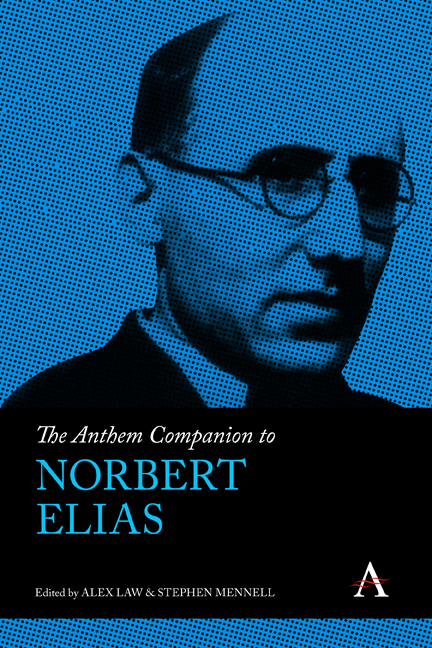Book contents
- Frontmatter
- Contents
- Notes On Contributors
- Acknowledgments
- Introduction: The Sociological Promise of Norbert Elias
- One Norbert Elias: Genesis of a Determined Thinker
- Two Knowledge, Science and Method: The Sociological Practice of Norbert Elias
- Three Norbert Elias’s Comparative Historical Sociology: Against Process Reduction
- Four Power and Process: Norbert Elias and the Paradox of Inequalities
- Five Norbert Elias and Shifting Gender Relations
- Six Travelling With Elias: Figurations and the Racialising Process in South Africa
- Seven Excitement Processes, Embodiment and Power Relations in Sport and Leisure
- Eight Warfare, Survival Units, National Habitus and Nationalism: Norbert Elias’s Contribution to Political Sociology
- Nine Elias’s Contribution to International Relations Theory: Towards a Global Sociology
- Ten Crime, Government and Civilisation: Rethinking Elias in Criminology
- Eleven Art and the Civilising Process
- Twelve From Social Mobility to Channels of Opportunity: Norbert Elias and Education
- Appendix: Published Works of Norbert Elias in English
- Index
Eleven - Art and the Civilising Process
Published online by Cambridge University Press: 28 February 2024
- Frontmatter
- Contents
- Notes On Contributors
- Acknowledgments
- Introduction: The Sociological Promise of Norbert Elias
- One Norbert Elias: Genesis of a Determined Thinker
- Two Knowledge, Science and Method: The Sociological Practice of Norbert Elias
- Three Norbert Elias’s Comparative Historical Sociology: Against Process Reduction
- Four Power and Process: Norbert Elias and the Paradox of Inequalities
- Five Norbert Elias and Shifting Gender Relations
- Six Travelling With Elias: Figurations and the Racialising Process in South Africa
- Seven Excitement Processes, Embodiment and Power Relations in Sport and Leisure
- Eight Warfare, Survival Units, National Habitus and Nationalism: Norbert Elias’s Contribution to Political Sociology
- Nine Elias’s Contribution to International Relations Theory: Towards a Global Sociology
- Ten Crime, Government and Civilisation: Rethinking Elias in Criminology
- Eleven Art and the Civilising Process
- Twelve From Social Mobility to Channels of Opportunity: Norbert Elias and Education
- Appendix: Published Works of Norbert Elias in English
- Index
Summary
Introduction
Norbert Elias was steeped not only in developments in biology, psychology, philosophy, history and, of course, sociology, but he was also deeply immersed in literature, art, architecture, sport and leisure culture more generally (Steuerwald 2018). Problems of art that first intrigued Elias in his twenties formed an abiding concern throughout his long lifetime. In some ways, the Breslau of Elias's youth was a rather unpromising environment for sustaining a habitus oriented towards art. Until the 1920s, Breslau had been something of a cultural backwater with ‘few contemporary artists of note and no real artistic milieu, with few galleries, exhibition spaces, arts cafes, or salons’ (Barnstone 2016, 111). Even so, Elias cultivated an aesthetic disposition. As a student at Breslau he learned from the ethno-nationalist art historian (and later Nazi) Wilhelm Pinder (1878–1947) of the significance of inter-generational shifts in artistic taste and from August Grisebach (1881–1950), a specialist in Renaissance and nineteenth-century architecture, how an artwork like the Ghent altarpiece was a product of the emergent Flemish bourgeoisie (Jitschin, chapter one, this volume). In a precocious essay of 1921 Elias (2006a) explored the relationship between the sensual experience of art and the scientific understanding of nature. A few years later he began to work for an abandoned Habilitation thesis supervised by Alfred Weber on the historical sociology of painting and the natural sciences (Elias 2006d), a theme that would resurface in 1987 with his Involvement and Detachment (Elias 2007, 37–63). In the 1930s, Elias was personally acquainted with critical theorists Walter Benjamin and Theodor Adorno and became a close confidante of Karl Mannheim around the time that Mannheim (1956) was developing his model of the democratisation of culture. Within Mannheim's research group, Elias influenced Mannheim's doctoral student Gisele Freund's pioneering research on the sociology of photography, Nina Rubinstein's thesis on the aristocratic émigrés of 1789, Margarete Freudenthal's study of women and structural changes in the urban bourgeois family household, while Jitschin (Chapter 1 this volume) suggests that his approach to aristocratic romanticism was, at least in part, indebted to Natalie Halperin's doctoral thesis on eighteenth-century German women writers (Kettler et al. 2008).
- Type
- Chapter
- Information
- The Anthem Companion to Norbert Elias , pp. 205 - 230Publisher: Anthem PressPrint publication year: 2023

